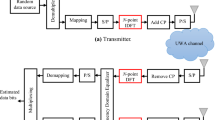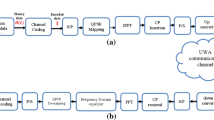Abstract
The era of intelligence has arrived. Intelligent multimodal information is essential for underwater engineering. Sound is an indispensable medium in underwater multi-modal information technology. Orthogonal frequency division multiplexing underwater acoustic communication technology can achieve high bit rate communication. However, the time-varying Doppler of the underwater acoustic channel will cause inter carrier interference in the OFDM system, destroy the orthogonality between subcarriers, and affect system performance. In this paper, we propose a method based on wavelet function to compensate for the Doppler distortions of the underwater acoustic channel for OFDM data. This method uses a set of orthogonal polynomials to perform channel estimation in both the time and frequency domains and uses the matched filtering for channel equalization. Compared with the traditional polynomials, the smoothly varying polynomials in Wavelet FFT greatly reduces the correlation of the processed data, enable more accurate channel estimation and equalization. Finally, this paper verifies the feasibility of the algorithm through the Songhua Lake underwater experiment.









Similar content being viewed by others
References
Li G, Hu A, Zhang J, Peng L, Sun C, Cao D (2018) High-agreement uncorrelated secret key generation based on principal component analysis preprocessing. IEEE Trans Commun 66(7):3022–3034
Yu J, Hu A, Li G, Peng L (2019) A robust RF fingerprinting approach using multi-sampling convolutional neural network. IEEE Internet Things J 6(4):6786–6799
Xiang, Li, Wen-De, et al (2014) Channel equalization in optical OFDM systems using independent component analysis. J Lightwave Technol 32(18): 3206–3214
Qi P, Li Z, Li H, Xiong T (2018) Blind sub-Nyquist Spectrum sensing with modulated wideband converter. IEEE Trans Veh Technol 67(5):4278–4288
Zhou JT, Tsang IW, Pan SJ et al (2019) Multi-class heterogeneous domain adaptation. J Mach Learn Res 20(57):1–31
Sultana A, Fernando X, Zhao L (2017) An overview of medium access control strategies for opportunistic spectrum access in cognitive radio networks. Peer-to-Peer Networking Appl 10(5):1113–1141
Lohn JD, Becker JM, Linden DS (2011) An evolved anti-jamming adaptive beamforming network. Genet Program Evolvable Mach 12(3):217–234
Li B, Huang J, Zhou S et al (2009) MIMO-OFDM for high-rate underwater acoustic communications. IEEE J Ocean Eng 34(4):634–644
Ahmed M, Salleh M, Channa MI (2018) Routing protocols based on protocol operations for underwater wireless sensor network: a survey. Egyptian Inform J 19(1):57–62
Zhu X, Champagne B, Zhu WP (2014) Rao test based cooperative spectrum sensing for cognitive radios in non-Gaussian noise. Signal Process 97:183–194
Lin Y, Zhu X, Zheng Z, Dou Z, Zhou R (2019) The individual identification method of wireless device based on dimensionality reduction and machine learning. J Supercomput 75(6):3010–3027
Lin Y, Tu Y, Dou Z (2020) An improved neural network pruning Technology for Automatic Modulation Classification in edge devices. IEEE Trans Veh Technol 69(5):5703–5706
Zorita EV, Stojanovic M (2015) Space–frequency block coding for underwater acoustic communications. IEEE J Ocean Eng 40(2):303–314
Schniter P (2004) Low-complexity equalization of OFDM in doubly selective channels. IEEE Trans Signal Process 52(4):1002–1011
Chen C, Zhuge Q, David V, Plant (2011) Zero-guard-interval coherent optical OFDM with overlapped frequency-domain CD and PMD equalization. Optics Express 19(8):7451–7467
Aval YM, Stojanovic M (2015) Differentially coherent multichannel detection of acoustic OFDM signals. IEEE J Ocean Eng 40(2):251–268
Ma X, Wang T, Lin Y, Jin S (2018) Parallel iterative inter-carrier interference cancellation in underwater acoustic orthogonal frequency division multiplexing. Wirel Pers Commun 102(2):1603–1616
Zakharov YV, Morozov AK (2015) OFDM transmission without guard interval in fast-varying underwater acoustic channels. IEEE J Ocean Eng 40(1):144–158
Tu K, Fertonani D, Duman TM, Stojanovic M, Proakis JG, Hursky P (2011) Mitigation of Intercarrier interference for OFDM over time-varying underwater acoustic channels. IEEE J Ocean Eng 36(2):156–171
Han J, Zhang L, Leus G (2016) Partial FFT demodulation for MIMO-OFDM over time-varying underwater acoustic channels. IEEE Signal Processing Letters 23(2):282–286
Lee S, Kiseon K (2012) Localization with a Mobile Beacon in underwater acoustic sensor networks. SENSORS 12(5):5486–5501
Berger CR, Zhou S, Preisig JC et al (2010) Sparse Channel estimation for multicarrier underwater acoustic communication: from subspace methods to compressed sensing. IEEE Trans Signal Process 58(3):1708–1721
Liu S, Pan Z, Cheng X (2017) A novel fast fractal image compression method based on distance clustering in high dimensional sphere surface. Fractals-Complex Geomet Patterns Scaling Nat Soc 25(04):1740004
Wang X, Liu KJR (2002) An Adaptive Channel estimation algorithm using time-frequency polynomial model for OFDM with fading multipath channels. Eurasip J Appl Signal Processing 2002(8):818–830
Wen JH, Chiang CH, Hsu TJ, Hung HL (2012) Resource management techniques for OFDM systems with the presence of inter-carrier interference. Wirel Pers Commun 65(3):515–535
Liu S, Guo C, Al-Turjman F, Muhammad K (2020) Reliability of response region: A novel mechanism in visual tracking by edge computing for IIoT environments. Mech Syst Signal Process 138:106537
Acknowledgments
This work was supported by the following projects: Equipment Prophetic Field Fund (No. 61404150301), Heilongjiang Natural Science Foundation Joint Guidance Project (No. HL2019A006), Equipment Pre-Study Ship Heavy Industry Joint Fund (No. 6141B042865), Underwater Information and Control Key Laboratory Open Fund (No. 6142218061812), Xiamen University Education Fund (No. UAC201804).
Author information
Authors and Affiliations
Corresponding author
Additional information
Publisher’s Note
Springer Nature remains neutral with regard to jurisdictional claims in published maps and institutional affiliations.
Rights and permissions
About this article
Cite this article
Ma, X., Wang, T., Li, L. et al. Doppler Compensation of Orthogonal Frequency Division Multiplexing for Ocean Intelligent Multimodal Information Technology. Mobile Netw Appl 25, 2351–2358 (2020). https://doi.org/10.1007/s11036-020-01609-0
Published:
Issue Date:
DOI: https://doi.org/10.1007/s11036-020-01609-0




